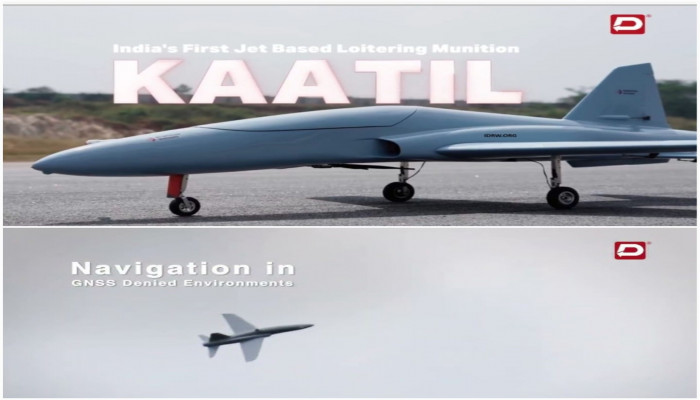Dynauton Systems to Introduce 'Kaatil', India's Jet-Powered Loitering Munition
- In Reports
- 05:20 PM, Feb 08, 2025
- Myind Staff
A division called Dynauton Systems of Dynamatic Technologies Limited is getting ready to present its innovation, a new edition, to the nation's defence arsenal at Aero India 2025. It is going to showcase “Kaatil,” which is the first Indian jet-based loitering munition. It will introduce India’s increasing prowess in indigenous defence technology.
Kaatil, which means "killer" in Hindi, is an advanced loitering munition developed indigenously by Dynauton Systems. Unlike conventional loitering munitions, it comes with landing gear, allowing it to take off like a standard UAV. This unique feature enhances its operational versatility and even enables reuse in specific situations.
Weighing just 12 kilograms at takeoff, Kaatil is a lightweight yet powerful loitering munition capable of carrying a 1-kilogram payload. Its design features a 2-meter wingspan, and with jet propulsion, it can reach impressive speeds of up to 600 kmph. This high speed gives it a significant edge over traditional propeller-driven loitering munitions, enabling faster response times and the ability to strike targets across a larger area.
Kaatil is touted as a "fire and forget" system, allowing it to independently locate and smash its target after being launched, without needing any further interference from any guider or being. This feature is especially important in environments where GNSS (Global Navigation Satellite System) signals are unavailable or disrupted, making traditional navigation unreliable. Kaatil's integrated navigation system allows it to carry out missions with exceptional accuracy, even in such conditions.
Kaatil has an endurance of 16 minutes at its Maximum Take-Off Weight (MTOW), allowing it to remain over a target area long enough to carry out a strike effectively. Its precision is demonstrated by a Circular Error Probable (CEP) of just 2 meters, making it one of the most accurate loitering munitions available. This high level of accuracy makes it ideal for striking high-value targets while minimising unintended damage.
Designed for fully autonomous operations, Kaatil can execute precision strikes without requiring human intervention after launch. This advanced autonomy represents a prominent step forward in combat technology, enhancing operational effectiveness while reducing risks for human operators, especially in high-threat environments.
The integration of Kaatil into India's defence arsenal is expected to bring significant advantages, influencing both tactical missions and broader strategic deterrence. With its combination of speed, precision, and autonomy, Kaatil has the potential to transform India's approach to aerial combat and precision targeting in modern warfare.







Comments